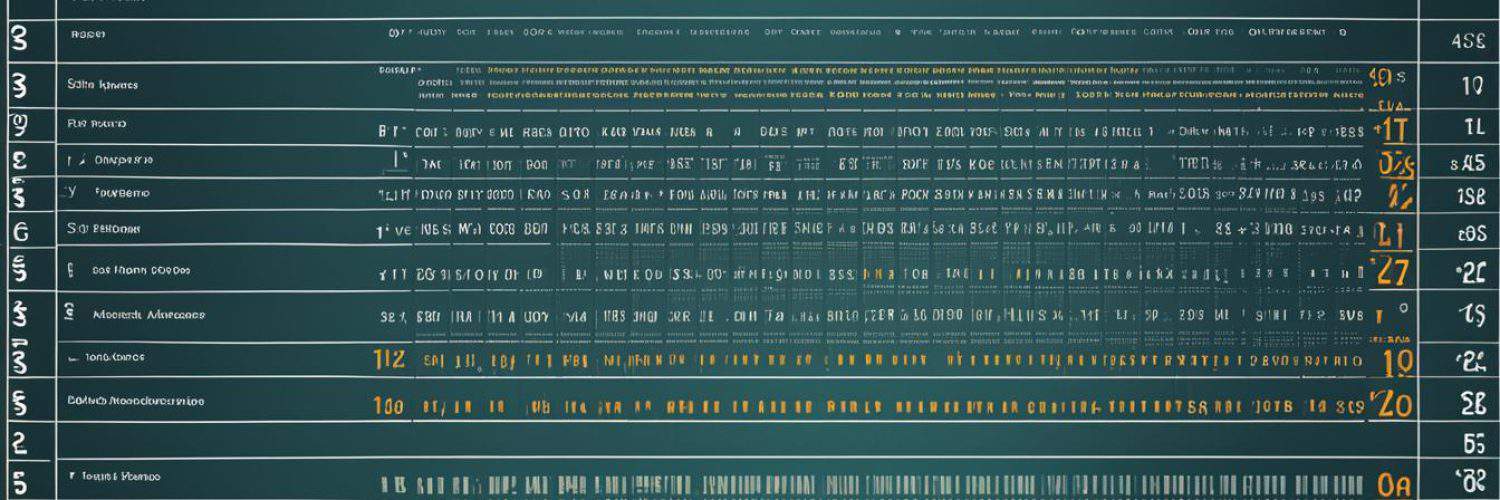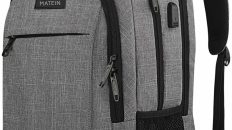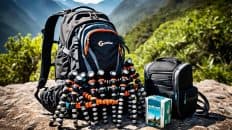Welcome to the ultimate guide to the best travel hyperfocal distance chart for your photography needs. If you’re a landscape or night photographer looking to capture stunning images with maximum depth of field, then the hyperfocal distance chart is an indispensable tool. By understanding and using the hyperfocal distance chart effectively, you can ensure that everything from half of the calculated distance to infinity is sharp and in focus in your travel photographs.
With the help of a hyperfocal distance calculator and chart, you can quickly determine the hyperfocal distance based on your camera, focal length, and aperture settings. This allows you to achieve the desired level of sharpness and detail in your images, even when using short focal lengths. Whether you’re exploring breathtaking landscapes or capturing the beauty of the night sky, the hyperfocal distance chart is your key to creating remarkable travel photographs.
Key Takeaways:
- The hyperfocal distance chart is essential for landscape and night photographers who want to maximize depth of field.
- It allows photographers to calculate the hyperfocal distance quickly based on their camera, focal length, and aperture settings.
- By focusing at the hyperfocal distance, everything from half of that distance to infinity will be acceptably sharp in the image.
- Using the hyperfocal distance chart effectively can greatly enhance the quality and impact of your travel photography.
- With the right hyperfocal distance chart, you can capture stunning landscapes with everything in focus, from the foreground to the distant horizon.
Now that you understand the importance of the hyperfocal distance chart for travel photography, let’s dive deeper into the concept of hyperfocal distance and how to calculate it accurately.
Understanding Hyperfocal Distance
Hyperfocal distance is a fundamental concept in photography that allows photographers to achieve maximum depth of field. It refers to the distance at which a lens should be focused to ensure everything from half of that distance to infinity is in sharp focus. This technique is particularly useful in landscape photography, where capturing a wide range of details and maintaining sharpness throughout the scene is crucial.
To calculate the hyperfocal distance, several factors need to be taken into account. These include the lens focal length, aperture, and the circle of confusion, which is a measure of acceptable blur in an image. By understanding and manipulating these variables, photographers can accurately determine the hyperfocal distance and achieve the desired sharpness in their photographs.
The calculation of hyperfocal distance involves intricacies that may seem daunting at first, but with practice, it becomes second nature. Fortunately, there are tools and resources available to simplify the process. Let’s take a closer look at how to calculate and utilize hyperfocal distance effectively.
Calculating Hyperfocal Distance
The formula for calculating hyperfocal distance takes into account the lens focal length, aperture, and the circle of confusion. The circle of confusion represents the acceptable level of blur in an image and varies depending on factors such as the camera sensor size and personal preferences.
To calculate the hyperfocal distance, use the following formula:
Hyperfocal Distance = (focal length^2)/(aperture x circle of confusion)
Where:
- Focal length: The focal length of the lens used for the photograph.
- Aperture: The chosen aperture setting, represented by the f-number.
- Circle of confusion: The desired value for acceptable blur, depending on the camera sensor size and personal preferences.
Using this formula, photographers can determine the hyperfocal distance for their specific camera settings and achieve optimal depth of field.
The Benefits of Hyperfocal Distance
Understanding and utilizing hyperfocal distance has numerous advantages for travel photographers. By focusing at the hyperfocal distance, they can capture photographs with a wide range of details, where both the foreground and distant elements remain in sharp focus. This technique allows photographers to create visually stunning images that draw the viewer into the scene.
Additionally, using hyperfocal distance can maximize the potential of wide-angle lenses, which naturally have a deeper depth of field. It enables photographers to create more impactful compositions, as the sharpness throughout the entire frame enhances the overall aesthetic quality of the photograph.
By mastering hyperfocal distance, travel photographers can elevate their images and convey the awe-inspiring beauty of the landscapes they encounter.
What is the Circle of Confusion?
In the world of photography, the term “circle of confusion” refers to a measure of acceptable blur in an image before it becomes noticeable to the viewer. This concept plays a crucial role in hyperfocal distance calculations, as it helps determine the level of sharpness that can be achieved in a photograph.
The circle of confusion is influenced by the camera’s sensor size, which is the surface area that captures the image. For full-frame sensors, the standard value for the circle of confusion is around 0.03mm, while for APS-C sensors, it is typically around 0.02mm. These values serve as a benchmark to determine the acceptable amount of blur.
Understanding the concept of the circle of confusion is vital when using a hyperfocal distance table. This table takes into account the specific circle of confusion value for a camera’s sensor size, along with other variables such as focal length and aperture. By consulting the hyperfocal distance table, photographers can determine the appropriate hyperfocal distance to achieve the desired level of sharpness in their photographs.
Using the circle of confusion as a guideline, photographers can ensure that their images maintain a high level of clarity and sharpness, enhancing the overall quality of their work.
Example of a Hyperfocal Distance Table
| Focal Length (mm) | Aperture | Full Frame Hyperfocal Distance (m) | APS-C Hyperfocal Distance (m) |
|---|---|---|---|
| 10 | f/8 | 1.01 | 0.68 |
| 20 | f/11 | 2.69 | 1.81 |
| 35 | f/16 | 5.91 | 3.97 |
| 50 | f/22 | 10.9 | 7.32 |
This example of a hyperfocal distance table showcases different focal lengths and corresponding apertures, along with their respective hyperfocal distances for both full-frame and APS-C sensors. The table offers a convenient reference for photographers who want to quickly determine the hyperfocal distance for specific camera settings, ensuring optimal sharpness and depth of field in their images.
How Focal Length, Aperture, and Sensor Size Affect Hyperfocal Distance
Focal length, aperture, and sensor size are key factors that influence the hyperfocal distance in travel photography. Understanding how these variables interact will allow you to make informed decisions when using a hyperfocal distance chart for optimal image quality.
1. Focal Length:
The focal length of your lens plays a crucial role in determining the hyperfocal distance. As the focal length increases, the angle of view narrows, leading to a shallower depth of field and ultimately a shorter hyperfocal distance. Conversely, shorter focal lengths provide a wider angle of view and a greater depth of field, resulting in a longer hyperfocal distance.
2. Aperture:
The aperture setting also has a significant impact on hyperfocal distance. Larger apertures (smaller f-numbers) produce a shallower depth of field, leading to a shorter hyperfocal distance. On the other hand, smaller apertures (larger f-numbers) increase the depth of field and extend the hyperfocal distance. It’s important to consider the artistic effect and desired sharpness when selecting an aperture setting.
3. Sensor Size:
The size of your camera’s sensor affects the hyperfocal distance as well. Generally, larger sensors produce a shallower depth of field compared to smaller sensors when using the same focal length and aperture. Consequently, larger sensors require shorter hyperfocal distances to maintain sharpness throughout the frame, making them ideal for travel photography.
By understanding the relationship between focal length, aperture, and sensor size, you can effectively manipulate the hyperfocal distance to achieve the desired depth of field in your travel photographs.
Comparing the Effects of Focal Length, Aperture, and Sensor Size
| Focal Length | Aperture | Sensor Size | Hyperfocal Distance |
|---|---|---|---|
| Wide-angle (e.g., 18mm) | Small (e.g., f/8) | Full-frame | Long (e.g., 2 meters) |
| Telephoto (e.g., 200mm) | Large (e.g., f/2.8) | APS-C | Short (e.g., 1 meter) |
| Standard (e.g., 50mm) | Medium (e.g., f/5.6) | Micro Four Thirds | Moderate (e.g., 1.5 meters) |
As demonstrated in the table above, different combinations of focal length, aperture, and sensor size yield varying hyperfocal distances. Travel photographers must consider these factors and adapt their approach accordingly to capture stunning images with the desired depth of field.
Remember, choosing the best hyperfocal distance chart and mastering the art of utilizing it effectively will significantly enhance your travel photography. By comprehending how focal length, aperture, and sensor size influence hyperfocal distance, you can capture compelling images that showcase the beauty of each location you explore.
How to Use the Hyperfocal Distance Chart
The hyperfocal distance chart is an essential tool for travel photographers looking to calculate the hyperfocal distance quickly and accurately for their camera, focal length, and aperture settings. By using the chart, photographers can ensure that their images have maximum depth of field, capturing sharp details from the foreground to the distant horizon.
Using the hyperfocal distance chart is straightforward. Simply locate the values for your camera, focal length, and aperture in the chart below, and you’ll find the corresponding hyperfocal distance. Remember that hyperfocal distance increases with increasing focal length and aperture, which results in a shallower depth of field. Conversely, decreasing the focal length and aperture narrows the hyperfocal distance, allowing for a greater depth of field in your images.
| Camera | Focal Length | Aperture | Hyperfocal Distance |
|---|---|---|---|
| Canon EOS R | 35mm | f/8 | 5.5m |
| Nikon Z6 II | 24mm | f/11 | 7m |
| Sony Alpha A7 III | 50mm | f/16 | 12m |
Once you have determined the hyperfocal distance for your specific camera settings, you can set your focus accordingly. By focusing at or slightly beyond the hyperfocal distance, you ensure that everything from the foreground to infinity is acceptably sharp in your photos. It’s important to note that the hyperfocal distance varies depending on the camera, focal length, and aperture combination, so referring to the chart each time is crucial for accurate focus.
Remember, the hyperfocal distance chart is a valuable tool for travel photographers seeking to capture impactful and detailed images with maximum depth of field. By understanding how to use the chart effectively, you can elevate your travel photography and create stunning visuals that capture the beauty of every landscape you encounter.
How to Focus at the Hyperfocal Distance
Focusing at the hyperfocal distance is a critical technique for capturing sharp and detailed images in travel photography. To achieve this, precision and careful measurement are necessary. Here are some tips to help you focus at the hyperfocal distance:
- Use tools for accurate measurement: Tools such as a torch or an augmented reality app can aid in accurately measuring the distance. By ensuring precise measurement, you can focus more effectively at the hyperfocal distance.
- Focus slightly beyond the hyperfocal distance: To ensure that all background elements also remain in focus, it’s recommended to focus slightly beyond the calculated hyperfocal distance. This technique allows you to capture sharpness from the foreground to infinity.
- Switch to manual focus: Once you have set the focus using the automatic mode, switch to manual focus to prevent any unintentional changes while shooting. This ensures consistency in the focus distance throughout the photography session.
By mastering the technique of focusing at the hyperfocal distance, you can enhance the depth of field in your travel photographs, resulting in stunning images that capture every detail from the nearest objects to the distant horizon.
Advantages of Using a Hyperfocal Distance Chart
Using a hyperfocal distance chart offers several advantages for travel photographers. It allows for maximum depth of field, ensuring that everything from the foreground to the distant horizon is in focus. This is particularly important in landscape photography where multiple planes of interest are present.
Additionally, using a hyperfocal distance chart can improve overall sharpness and detail in images. By accurately setting focus at the hyperfocal distance, photographers can capture crisp and clear shots that showcase the intricate details of each scene.
Furthermore, using a hyperfocal distance chart provides a faster and more efficient way to set focus, saving valuable time during a photo shoot. Instead of manually adjusting focus or relying on autofocus, photographers can refer to the chart and quickly determine the optimal focal distance for their specific camera settings.
“A hyperfocal distance chart is an invaluable tool for travel photographers looking to capture stunning landscapes with pristine sharpness and depth. It streamlines the focus-setting process, allowing photographers to devote more time to composition and creativity.”
Overall, incorporating a hyperfocal distance chart into travel photography techniques can greatly enhance the quality and impact of images. With its ability to maximize depth of field, improve image sharpness, and provide a faster focus-setting method, a hyperfocal distance chart is an essential companion for any travel photographer.
Limitations of Using a Hyperfocal Distance Chart
While a hyperfocal distance chart is a valuable tool for travel photographers, it’s important to understand its limitations. These limitations include assumptions about the circle of confusion, individual viewer preferences, and camera settings.
The hyperfocal distance chart assumes a standard circle of confusion, which may not align with the specific preferences of individual viewers. Some viewers may have a higher tolerance for blur, while others may be more sensitive to it. It’s essential for photographers to consider the intended audience and adjust the hyperfocal distance accordingly.
Moreover, different camera settings can impact the accuracy of the hyperfocal distance chart. Variations in sensor size, aperture performance, and lens characteristics can affect depth of field and, subsequently, the hyperfocal distance calculations. Photographers should be aware of these variations and make adjustments as necessary to achieve the desired results.
Another limitation to consider is the use of wide apertures for smaller hyperfocal distances. When shooting with a wide aperture, such as f/1.4 or f/2.8, for a close subject or a small hyperfocal distance, diffraction can occur and affect image quality. This may result in reduced sharpness and overall image degradation. Photographers should be cautious when using wide apertures and take diffraction into account when setting the hyperfocal distance.
To overcome these limitations, experimentation and practice are key. By testing different settings, understanding the capabilities of the camera and lens, and considering viewer preferences, photographers can refine their use of the hyperfocal distance chart. Adapting to specific shooting conditions and continuously learning from the results will ultimately lead to more effective and impactful travel photography.
Hyperfocal Distance Table in PhotoPills App
The PhotoPills app offers a convenient solution for travel photographers seeking accurate hyperfocal distance calculations. With the included hyperfocal distance table, photographers can easily access the necessary information on the go.
In addition to providing the hyperfocal distance values, the PhotoPills app offers a unique augmented reality view. This feature allows photographers to visualize where to focus in real-time, making it easier to set the desired hyperfocal distance quickly and accurately.
By combining the hyperfocal distance table with the augmented reality view, photographers can make precise focus adjustments on location, ensuring their images are sharp and well-focused. This added convenience makes the PhotoPills app an invaluable tool for travel photographers who want to optimize their hyperfocal distance for optimal depth of field.
Furthermore, the PhotoPills app offers additional resources and guides to help photographers enhance their skills and improve their travel photography. With a wealth of information at your fingertips, the app becomes a comprehensive tool for better understanding hyperfocal distance and mastering its application in travel photography.
Tips for Using the PhotoPills App:
- Make sure to input accurate camera, focal length, and aperture settings to obtain precise hyperfocal distance calculations.
- Take advantage of the augmented reality view to visualize focus points and adjust accordingly.
- Explore the app’s additional resources and guides to expand your knowledge and improve your photography skills.
- Regularly update the app to access new features and improvements that will enhance your photography experience.
With the PhotoPills app and its hyperfocal distance table, travel photographers can effortlessly optimize their depth of field and capture breathtaking images with exceptional sharpness. Don’t miss out on this invaluable tool that will elevate your travel photography to new heights.
Printable Hyperfocal Tables
For travel photographers who prefer a physical reference, printable hyperfocal tables are a valuable resource. These tables provide hyperfocal distance values for different focal lengths and apertures based on the camera’s sensor size. By selecting the appropriate values from the table, photographers can quickly determine the hyperfocal distance for their specific camera settings, ensuring accurate calculations.
It’s vital to choose a table that matches the camera’s sensor size to ensure precise calculations. This ensures that the hyperfocal distance chart is tailored to the specific camera setup, providing the most accurate results. Travel photographers can easily access and carry these printable tables in their bags during shoots, allowing for quick and convenient reference when adjusting focus settings.
Example Printable Hyperfocal Table:
| Focal Length (mm) | Aperture | Camera Sensor Size | Hyperfocal Distance (m) |
|---|---|---|---|
| 24 | f/8 | Full-Frame | 2.7 |
| 35 | f/11 | APS-C | 5.2 |
| 50 | f/16 | Micro Four Thirds | 10.3 |
Table: Example Hyperfocal Distance Values for Different Camera Settings
By referring to these printable hyperfocal tables, travel photographers can easily determine the hyperfocal distance, ensuring maximum depth of field and sharpness in their images. These tables provide a convenient and tangible resource for photographers to achieve optimal focus settings, resulting in stunning travel photographs.
Conclusion
The hyperfocal distance chart is an invaluable tool for travel photographers looking to capture stunning images with maximum depth of field. Understanding how to calculate and use the hyperfocal distance allows photographers to achieve sharpness from the foreground all the way to the distant horizon. By incorporating the hyperfocal distance chart into their photography techniques, travel photographers can greatly enhance the quality and impact of their images.
Whether using a digital hyperfocal distance calculator, a printable hyperfocal table, or a smartphone app like PhotoPills, photographers have various options to access hyperfocal distance calculations. These tools provide convenience and accuracy, helping photographers focus at the optimal distance for breathtaking landscape shots.
By considering factors such as focal length, aperture, and sensor size, photographers can fine-tune their hyperfocal distance for different camera settings. This attention to detail ensures that every element in the frame remains sharp and in focus. With the best hyperfocal distance chart as their guide, travel photographers can capture stunning images that transport viewers to the beauty and grandeur of the locations they have visited.
FAQ
What is hyperfocal distance?
Hyperfocal distance is the distance at which a lens should be focused to achieve maximum depth of field in a photograph.
How do you calculate hyperfocal distance?
Hyperfocal distance can be calculated based on the lens focal length, aperture, and circle of confusion, which is a measure of acceptable blur in an image. There are hyperfocal distance calculators available that make this process quick and easy.
What is the circle of confusion?
The circle of confusion is a measure of acceptable blur in an image before it becomes noticeable to the viewer. It is used in hyperfocal distance calculations to determine the acceptable level of sharpness in an image.
How do focal length, aperture, and sensor size affect hyperfocal distance?
Focal length, aperture, and sensor size all play a role in determining the hyperfocal distance. Longer focal lengths, larger apertures, and larger sensors will result in a shorter hyperfocal distance, while shorter focal lengths, smaller apertures, and smaller sensors will result in a longer hyperfocal distance.
How do you use a hyperfocal distance chart?
To use a hyperfocal distance chart, you need to know the focal length and aperture settings of your lens. Locate these values on the chart, and the corresponding hyperfocal distance will be provided. Set your focus at this distance to achieve maximum depth of field.
How do you focus at the hyperfocal distance?
To focus at the hyperfocal distance, you can use tools like a torch or an augmented reality app to measure the distance accurately. It’s important to focus slightly beyond the hyperfocal distance to ensure that all background elements are in focus.
What are the advantages of using a hyperfocal distance chart?
Using a hyperfocal distance chart allows for maximum depth of field in your photographs, ensuring that everything from the foreground to the distant horizon is in focus. It also improves overall sharpness and detail in images.
What are the limitations of using a hyperfocal distance chart?
A hyperfocal distance chart assumes a standard circle of confusion and may not account for individual viewer preferences or different camera settings. Additionally, using a wide aperture for smaller hyperfocal distances can introduce diffraction, affecting image quality.
Where can I find a hyperfocal distance table in the PhotoPills app?
The PhotoPills app provides a hyperfocal distance table in its resources section. It offers an augmented reality view that helps visualize where to focus and allows for accurate adjustments on the go.
What are printable hyperfocal tables?
Printable hyperfocal tables are physical references that provide hyperfocal distance values for different focal lengths and apertures based on the camera’s sensor size. Photographers can select the appropriate values from the table for their specific camera settings.
Why is the hyperfocal distance chart important in travel photography?
The hyperfocal distance chart is important in travel photography because it allows photographers to capture sharp and detailed images with maximum depth of field. It ensures that everything from the foreground to the distant horizon is in focus, making it ideal for capturing landscapes and other travel-related scenes.







Add comment